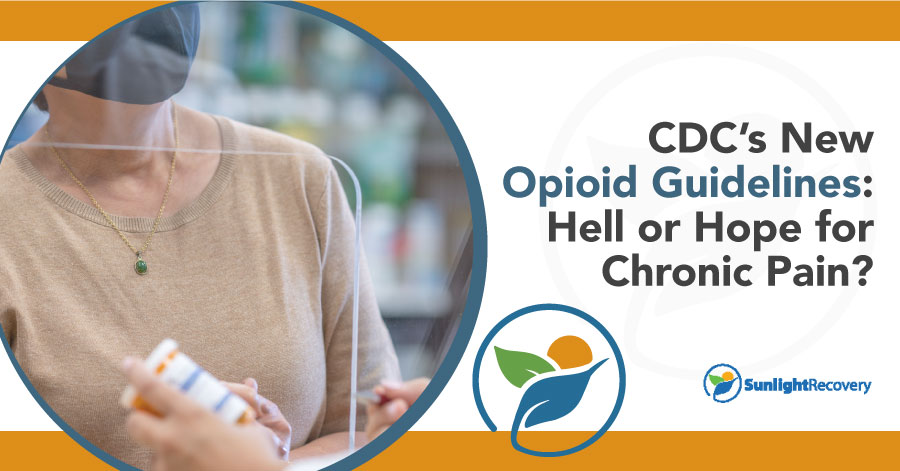Prescription opioids have been the go-to solution for those living with chronic pain for decades. They first became legal in the United States in the late 1700s and were used to treat those injured in the Civil War in the 1860s, many of whom became addicted. As a result, the federal government passed the Harrison Narcotics Act of 1914 to restrict the use of opioids.
Fast-forward about 80 years to the mid-90s when pharmaceutical companies introduced OxyContin, a new opioid-based pain reliever that was marketed as very effective in managing pain. According to the original FDA-approved label, addiction to this medication was very rare when used as directed. Prescriptions for this drug surged, and in 2012, the opioid dispensing rate peaked at 81.3 prescriptions per 100 people.
Unfortunately, these high dispensing rates correlated with a rise in opioid overdose deaths. Between 1999 and 2019, nearly 500,000 people died from opioids. (This number includes prescription and illicit opioids.) This increase came in three waves. The first wave came in the late-1990s when people began dying from prescription opioids. The second wave began in 2010 when there was a significant uptick in heroin-related deaths. The third wave began in 2013 when fentanyl became more common in synthetic opioids.
The Nation’s Response to Opioid Deaths
In 2016, the CDC published new opioid guidelines (which it would again update in 2022). The organization states that while the number of opioids prescribed since the 1990s has increased five-fold, Americans aren’t reporting less pain. It recognizes that prescription opioids can be an important tool for managing pain for some patients. However, its findings show that the relief patients experience is brief. There isn’t sufficient evidence to show that it’s an effective way to manage pain long-term.
In response to these preventable deaths, many health care providers have placed serious restrictions on who obtains prescription opioids. In the past decade, there’s been a 40 percent drop in the number of prescriptions written, with the Centers for Disease Control reporting that in 2020, the number of prescriptions per 100 people was 43.3.
The CDC’s guideline supports using non-opioid prescription medications, suggesting that these may be just as effective as opioids with less significant side effects and risk of addiction.
The 2016 CDC Guideline: What Does It Say?
The Guideline contains a dozen recommendations, all of which can be boiled down to three main points:
- Health care providers should use caution when prescribing opioids and monitor patients closely
- Health care providers should prescribe the lowest effective dosage possible to reduce the risk of addiction
- Non-opioid therapy recommendations don’t apply to those receiving treatment for cancer or who are in palliative and hospice care
Essentially, the guidelines suggest that rather than defaulting to prescription opioids, providers and patients should consider all their treatment options. When prescribing opioids was necessary, doctors should have patients take the smallest dose for the shortest duration possible for managing their pain. In most cases, it wasn’t recommended that people take opioids for more than three consecutive days.
Updated CDC Opioid Guidelines
In 2022, the CDC updated its guidelines for opioid prescriptions. In the guideline, the organization reiterated that opioids shouldn’t be the first line of defense against chronic pain, but it no longer suggested specific dosage ceilings. Instead, doctors should only prescribe opioids if they believe that the benefits will outweigh the risks to the patient. It also no longer suggests that treatment be limited to three days.
Doctors are encouraged to start patients off with the maximum dosages of pain relievers such as acetaminophen and use non-drug treatments such as rest, elevation, and physical therapy. Rather than taking regular doses at set times, patients should be instructed to take prescription opioids only as needed in no less than four-hour intervals. The CDC also says that doctors should educate their patients regarding the risks of opioid therapy.
Concerns About the New CDC Opioid Guidelines
While most people can agree that opioids have been over-prescribed and that taking actions to reduce the number of related deaths is necessary, there are concerns about how the new CDC opioid guidelines may affect patients. In some cases, hesitancy to utilize prescription opioids causes doctors to turn away patients living with chronic pain.
In a patient interview, one woman described her experience with doctors following the CDC’s 2016 guidelines. According to her account, after the guidelines were published, she had difficulty getting the medication she needed to manage her rheumatoid arthritis, which she was diagnosed with over 30 years prior at age 10. She states, “I had never had any problems with taking opioids. I always took them as directed.”
Like many people, the woman used opioids as instructed by her doctor as needed. Non-opioid medications were ineffective in managing her pain, so while she didn’t necessarily want to be on opioids, they were essential for her quality of life.
While the CDC guidelines were just that—guidelines, not rules or regulations—many states used them as the basis for putting new laws in place to limit how doctors prescribe opioids. In some cases, patients needed higher doses than what the CDC suggested, but doctors were either unable to prescribe the necessary dosage or were hesitant to do so for fear of a lawsuit.
Many doctors followed the CDC guidelines by prescribing fewer opioids, relying instead on non-opioid medications and non-drug treatments. While this undoubtedly reduced the number of unnecessary opioids in the hands of those vulnerable to developing an addiction, it led to a new problem of untreated pain. There are even reports of patients dying by suicide because their pain was unbearable. Other people turned to illicit opioids to manage their pain, making them even more vulnerable to risks of addiction and overdose.
Mixed Feelings on the New CDC Guidelines for Chronic Pain and Opioids
On the one hand, the new CDC guidelines for chronic pain management could be a good thing. It eliminated specific guidelines, leaving it to the discretion of the doctors. It also states more explicitly that the guidelines shouldn’t be used as a strict standard of care. This gives some people hope that doctors will be able to tailor prescription drug therapy to the needs of their patients, not a one-size-fits-all approach.
On the other hand, removing these guidelines takes away the clear parameters that doctors felt safe prescribing opioids within. According to Dr. Gary Franklin, a research professor at the University of Washington, “…if you take that help away by removing the specific guidance, it’s going to make [the doctors] uncomfortable again, and they’re not going to know what to do.”
Some are concerned that the new CDC opioid guidelines don’t go far enough, including Cindy Steinberg, the National Director of Policy and Advocacy for the U.S. Pain Foundation. She suggests that the CDC’s guidelines should have more precise recommendations for how doctors can prescribe opioids, saying, “I don’t think it goes far enough to protect patients from, really, the egregious, inhumane harms.”
While managing chronic pain can be challenging, there are doctors who specialize in using a variety of non-drug therapies, non-opioid medications and prescription opioids to help their patients stay comfortable. Some patients only have success with pain management through opioids. For those people, following their doctor’s orders and keeping communication lines open regarding how they’re feeling and if they experience withdrawal symptoms is important.
For those living with addiction to prescription or illicit opioids to manage pain, help is available. At Sunlight Recovery, we have a team of highly experienced licensed clinical and medical professionals that help patients through evidence-based opiate addiction treatment. To learn more, contact us today at (888) 402-3647.






